To starve or get rid of all boundaries? Such a choice is not a choice. A man in an extreme situation will eat anything to stay alive. What exactly?
We present the most moving and often repulsive cases from a century ago:from the difficult end of the 19th century and from the hungry years of the interwar period plunged into crisis. Cases often come from places that seem to be the richest and most civilized. What was eaten when there was no choice?
10. Smelly and spoiled garbage from the dumpster
During the Great Depression in the United States (i.e. from 1929 to the mid-1930s) in many restaurants guests were asked not to put out cigarettes in half-eaten dishes on their plates. And it wasn't about the convenience of the kitchen staff or the aesthetic tricks of the waiters.
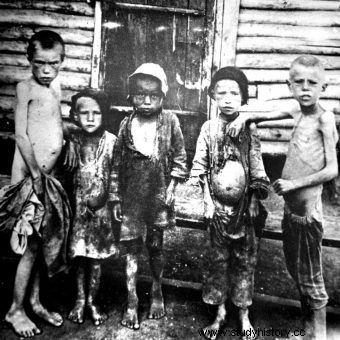
Great Famine in Ukraine 1932-1933 (Photo:Public Domain).
As Edmund Wilson describes it, quoted by Stephen Pimpare in his book "A People's History of Poverty in America":
There is no dumpster in Chicago that would not be haunted by the hungry. In hot weather last summer, when the smell was disgusting and the flies were greasy, a hundred people a day came to one of the garbage dumps. They threw themselves at the piles of rubbish as soon as the truck dumped them, and kicked at them with sticks and hands. They devoured all the flesh left on the old pieces of melon and cantaloupe until the skins were paper-thin. They took with them, washed and cooked discarded turnips, onions and potatoes.

During the Great Depression, African Americans had a gigantic problem with finding even the worst job. The photograph is from 1937.
One of the women described by Wilson, who, while rummaging in the garbage can nourished herself and her fourteen-year-old son, disgusted in a certain way. She always took off her glasses before picking up a piece of meat. This prevented her from seeing the larvae of flies swarming on him. The boy who had better eyesight sometimes couldn't bring himself to eat that stirring and smelly meal.
9. Crazy animals
Americans use the term "roadkill" to describe animals that have not survived a close encounter with a car. Today's vehicles move so fast that in such a situation they often drag out fragments of the killed creature over tens of meters of road before they stop.
As "They Eat That ?:A Cultural Encyclopedia of Weird and Exotic Food from around the World" explains, runaway creatures on the road are a relatively new problem that has emerged with the proliferation of automobiles. The authors enumerate that mammals most often die under the wheels, including squirrels, badgers, opossums, deer, cats, dogs, hedgehogs, rats and raccoons. Less often they are birds, including pheasants, ducks and pigeons. During the years of the Great Depression, eating runaway animals not only did not surprise anyone in America, but often - allowed to feed families. Although first it was necessary to scrupulously choose the glass from the carcass, and the freshness of the meat left a lot to be desired ...
8. Stray dogs
Pre-war Poland was not a rich country. The joy of regaining independence could not hide the gloomy reality. Many people were in a dire financial situation and help was not coming. The evening edition of the Warsaw newspaper "ABC" in 1934 informed that people deprived of a source of income in Lodz began not so much to eat the dogs, but to ... catch the dogs themselves. As reported by the newspaper:
There are more and more cases of killing dogs here, which are stolen by the unemployed for food. Such a theft was recently reported by Antoni Mahler. The police conducted an investigation and it turned out that the dog was stolen by Walerjan Sulbowicz, who, after keeping the dog at home for several days, killed and ate it.
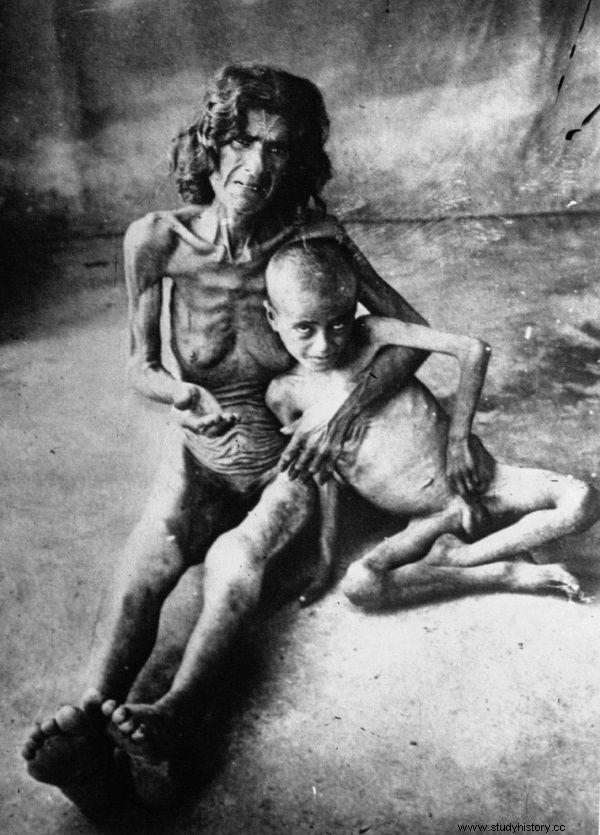
The defeat of the famine in Kazakhstan caused by the same moves by Stalin as in Ukraine, and its victims. (1933)
7. Weeds
In today's kitchen it is becoming fashionable to use wild plants or weeds from your own garden. Reaching for such a "greengrocer" is not a new discovery, however. In times of great economic downturns and famines, people searched for any source of food, not rejecting plants considered weeds.
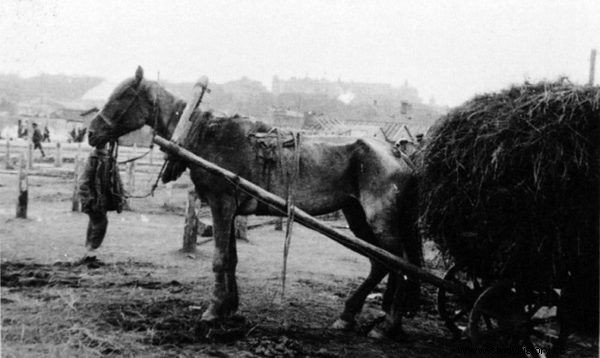
Hunger in Ukraine and its victim - an extremely emaciated horse on the verge of death.
Before World War II, for example, dandelion salad was popular. In spring, when the meadows turned green, people went for fresh leaves of this plant. In his book How I Lived and Laughed Through the Great Depression and Thereafter, Nickolas Petrovich describes how he went with his grandfather to get them. One time he picked up a lot of nuns, but the keeper immediately threw the greens away. He explained to the author that plants should never be eaten, but never picked up near the fence, because ... dogs pee there.
Once Nickolas Petrovich and his grandfather had collected the right amount of leaves, it was possible to make a salad out of them. They say it's best with olive oil, vinegar and crispy bacon.
6. Pig skins
Pig is eaten meat, fat and offal, while hides, as hard, tasteless and difficult to eat, should be omitted or used (as the name suggests) for leather products. The test times, however, make it necessary to verify the adopted rules.
William Wallace was 12 in 1933, a fifteen-year-old sister, a mother working in a canning factory, and a stepfather in a pig farm owned by an American politician. Even though the two adults had a job, it didn't mean they were able to support their family.

In an extreme situation, a human is also ready to consume a toad.
Fortunately, the canning factory was getting rid of pig skins, that is, waste that was seemingly completely unfit for consumption. Not for the Wallece's, because they were eating them perhaps not with good taste and with ease, but at least - with satisfaction. They also collected fruit and vegetables that had already been thrown away as spoiled, and my mother, with the help of low-quality molasses bought in a sugar factory, processed it all for the winter.
5. Toads
Many people are so disgusted with toads that they are unable to touch them without flinching. At the thought of eating them, you get a scowl of disgust. In addition, there is poison in the skin of these animals. Meanwhile, as J. Alan Holman notes in his book Amphibians and Reptiles of Michigan:A Quaternary and Recent Faunal Adventure, toads are… edible after all. At least in extreme situations.
According to information given to him by John Kilby, people who were starving during the Great Depression ate these creatures. It is said that cooking for a long time not only neutralizes the poison in the toad's skin, but also allows it to be easily removed for free access to the meat.
I don't know about you - I prefer not to check.
4. Tree bark
In Russia plunged into the Bolshevik revolution, fighting the "class enemy" and "kulaks", famines returned with alarming regularity. It wasn't much better before. In the two hundred years before the First World War, the Russians starved on average… every four years.

Real desperation from the Great Depression. Better to give away the children than starve them?
As described in a surprisingly humorous tone in the "Polish Word" of March 1899:
Admittedly today, people don't eat each other when they starve. The energy and the lack of resources to face starvation have diminished. Today's hungry eat grass, moss, bark, acorns and straw. Patients swell with hunger , they get sick and die more calmly from starvation typhus and other diseases, hunger-stricken organisms.
3. Picked leftovers
In the United States, during the Great Depression, many teenagers decided to leave their family home and hit the road. They didn't feel like adventuring at all; their hunger and hope for a better tomorrow were pushing them out into the world. They traveled stowaways by rail in freight cars. According to Errol Lincoln Uys in his book Riding the Rails. Teenagers on the Move During Great Depression ”, about 250,000 girls and boys were on the move! Often they were starving, or had some lousy scraps.
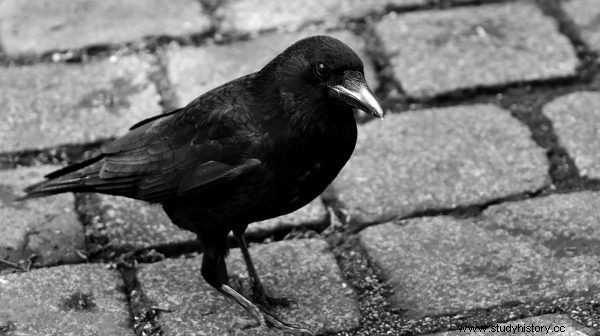
When hunger pressed, ravens were eaten as well.
Finally they decided to beg. They went from house to house, knocking at the back door, asking for food. More than once, instead of getting even scraps, they were beaten or pounded with dogs, but in many households they got leftovers from dinner scooped up on one plate or a dried slice of bread. One of such railroad tramps recalled years later that, for example, in search of food, he visited the Sunday school:
They evangelized me because they wanted to save my soul, which probably needed it. I was only there because I wanted to eat something. I felt like an intruder there and was ashamed.
2. Crows and Ravens
Crows and ravens were hardly ever included in poultry and included in the list of ingredients in popular dishes. However, when a country was hit by a famine, these birds were no longer safe. Of course, that didn't mean that people ate it with gusto.
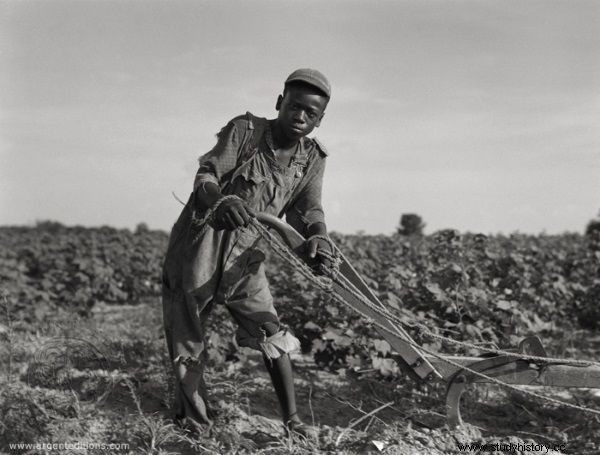
The inhabitants of countries in crisis did not despise any food. Most of all, however, they wanted to be able to work honestly and feed their families. (photo:public domain)
Among others, a certain Kolbuszowski wrote about it in the newspaper Przyrodnik. Popular biweekly on natural sciences ”(June 1887):
Apart from those countries where raven rights were taken care of, he was mostly disgusted with contempt. Jews are forbidden by their sacred books to eat raven flesh, neither do the savages eat it, and in our country, when a poor fellow tormented by hunger is forced to taste raven's meat, he always does so with great disgust.
1. Your own children
In the early 1930s, Soviet Russia began to introduce forced collectivization, brutally enforced by the authorities. The peasants were also imposed quotas beyond the capabilities of almost any rural family. This policy resulted in a devastating famine that hit Ukraine in 1932-1933.
As a result, entire villages were dying out; there were the most heinous crimes, overt acts of cannibalism. His cases are described, among others, by Robert Kuśnierz in the book "Ukraine in the years of collectivization and the Great Famine (1929-1933)":
Cannibalism wasn't unusual at the time. I myself saw how in Uman in the market square a woman was caught selling chops made of human meat , someone found a baby's toenail in a cutlet. People wanted to kill her there, but the police took her away.
The case of Ksenia Bolotnikova, a resident of the village of Sofijówka, who killed her own daughter, is also known. She may have started to suffer from starvation hallucinations, one of the documented effects of extreme malnutrition. Having killed her daughter, she cut off her head and put it in a pot. She cut the rest into pieces and buried them in the dung.
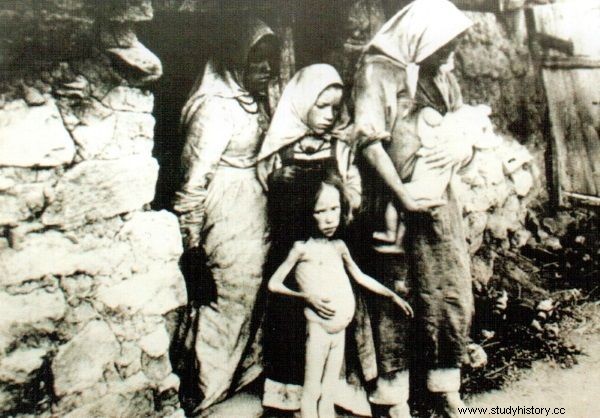
Great Famine in Ukraine. In the foreground a girl with a belly bloated from hunger. (photo:public domain).
Although it was forbidden to talk about it for decades, similar stories survived in the memory of ordinary Ukrainians. When I heard about Holodomor for the first time, it was from the mouth of an old Ukrainian woman whom I had known all my life. She told me that the hunger in the villages was so great that when two neighbors had their children died because of him, they exchanged their children so as not to eat their own offspring.
***
Pre-war Poland was a battlefield. For food, for work, for a decent life. But also for equality and for any prospects. This is what I am writing about in my latest book: "Twenty years from the kitchen".
Bibliography:
- "ABC", 1934.
- Cohen R., Dear Mrs. Roosevelt:Letters from Children of the Great Depression , 2002
- Kuśnierz R., Ukraine in the years of collectivization and the Great Famine (1929-1933), Toruń 2005.
- Petrovich N., How I Lived and Laughed Through the Great Depression and Thereafter , 2012.
- Pimpare S., A People's History of Poverty in America, 2011.
- "Naturalist. Popular biweekly on natural sciences ”, 1887.
- "Polish Word", 1899.
- They Eat That ?:A Cultural Encyclopedia of Weird and Exotic Food from around the World , eds. Deutsch J., Murakhver N., 2012.
